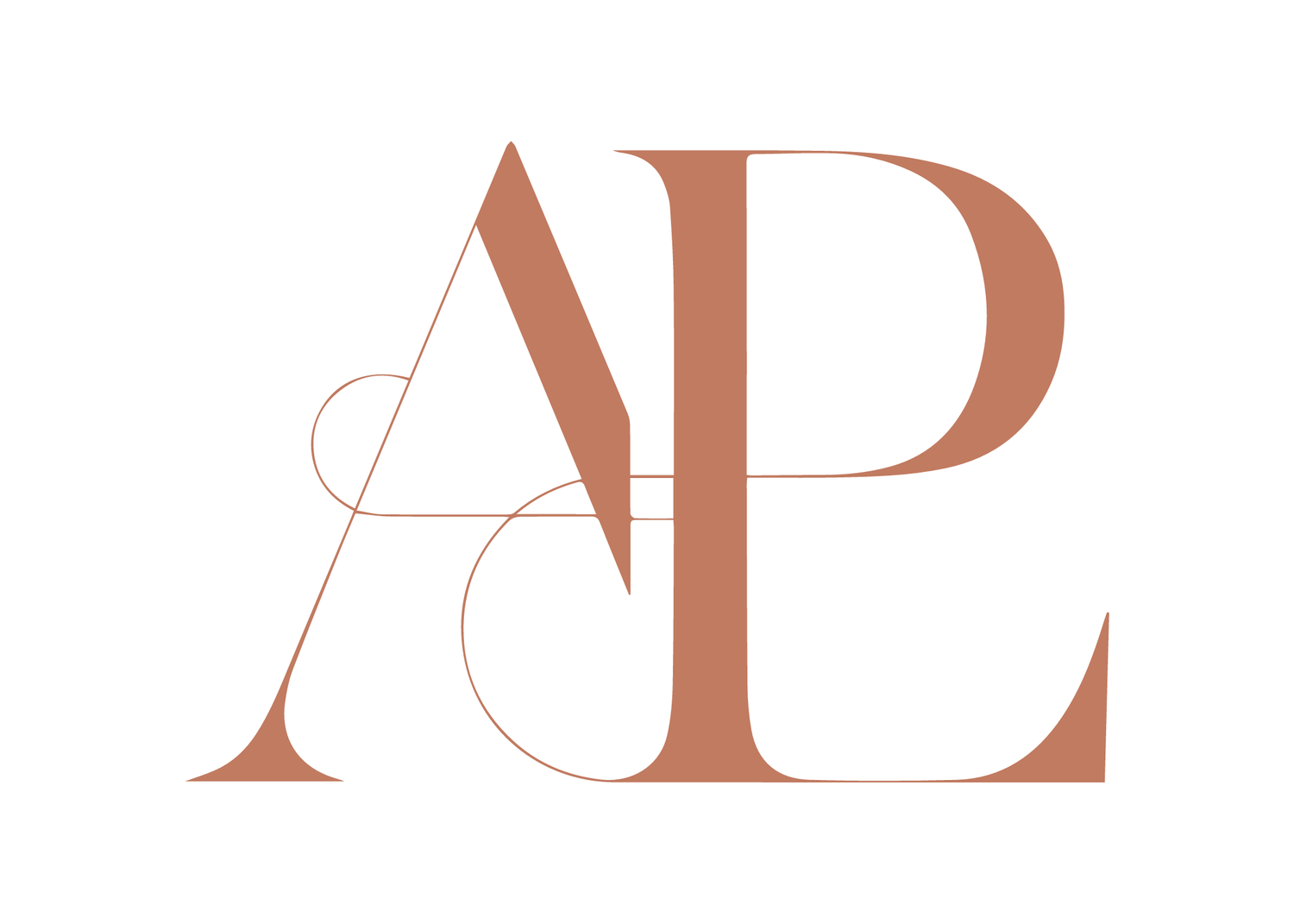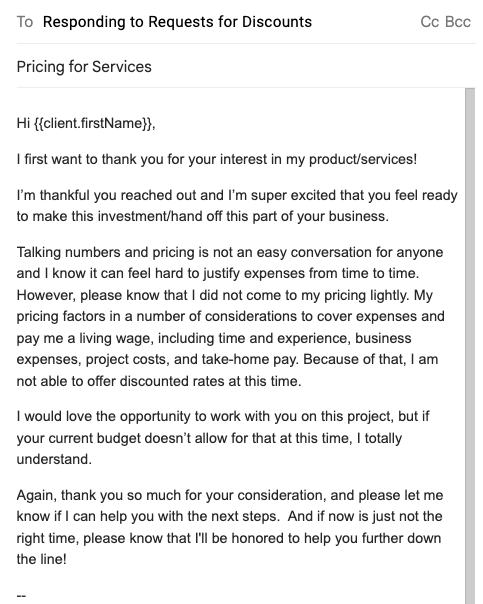Difficult Email Templates for Business Owners
As business owners, it really doesn't take long before your find yourself needing to respond to difficult clients or drafting difficult emails. That's why I created these email templates for business owners from my own responses to challenging situations.
You may find yourself in challenging situations with employees, contractors, or clients. Frustrations will arise and invisible lines will feel crossed.
When this happens, it takes courage and confidence to step up and say ‘no’ to situations that don’t support our best interests. But boundary setting is essential for business owners who want to grow and flourish instead of being swallowed up by negative circumstances.
Studies show that women are less likely than men to set boundaries, especially in business. This isn't surprising considering we women are socialized to help and trained to be people pleasers. It can feel wrong to prioritize our own needs. Being overwhelmed, overloaded, and exasperated... is often a result of our fear to say "no." We can start to lessen our burdens by setting boundaries first in our businesses.
Below, you'll find information about how to set boundaries that feel good for you and you'll be able to read my email templates for business owners.
5 Boundaries Every Business Owner Needs To Set
1. Establish communication guidelines.
When will you respond to clients/customers?
When will you be out of the office?
How should people reach you?
Do you respond to texts?
You need to honor these parameters you set --and doing that might be more challenging than you expect.
Get clear with clients and customers by using your email signature to communicate your upcoming “out of office” days, your office hours, and the best way to reach you.
Use your phone’s settings to turn off all notifications during your pre-established "downtime/rest time.” If you can’t stop checking emails, remove the email app from your phone altogether.
Use your “out of office” automated response to remind clients when they can expect a response.
2. Honor your offering and services.
Clearly communicate what one should expect from you and your services– before they book if you can.
Anticipate questions before they're asked and educate your clients throughout the process.
Don't let people demand more out of you than you've agreed to do -- especially if it's something that will consume a lot of your time.
3. Model how you'll be treated.
How you treat yourself and others determines how people will treat you. If you're not willing to honor your office hours, they won’t either. If you bend over backward for them, they’ll continue to expect you to do so.
Treat yourself with respect and show them how it's done.
4. Identify who you will and won't work with (and stop ignoring red flags.)
What types of clients will you take on? What's a NO client for you?
Knowing the answers to these questions ahead of time will make it that much easier for you to turn down ill-fitting clients when you're faced with them.
5. Honor your pricing.
Unless you pulled a number out of a hat, which hopefully you did NOT, your rates are your rates for good reason. Honor them. You don't owe anyone a discount.
4 Difficult Email Templates for Business Owners
(Swipe and Save These!)
TURNING A POTENTIAL CLIENT DOWN
The vibe is off. Red flags are raised. They’re totally not your type. You don’t feel inspired. Or excited. Whatever the reason - you know deep down you should turn down this person who wants to pay for your services.
But how? How do you say, “thanks, but no thanks” without sounding like a jerk?
Knowing your value means knowing when to say no, and I believe that’s especially true when saying no to potential clients. (Turning down money! What?! Who does she think she is?)
But if the truth is “you’re not the right fit”, tell them that. Honestly, letting them know is one of the kindest things you can do for them. They may even thank you for it.
To begin, swipe this template and save it in your email system for next time. No muss. No fuss.
WHY IT WORKS
The tone is appreciative of their desire to work with you.
It empresses your primary concern - for them and their needs (rather than a concern for self).
It ends in a positive tone.
RESPONDING TO A DISCOUNT REQUEST
The dreaded discount request. You spent weeks, months, years determining your rates, and then someone sees them and balks. It’s enough to stir up the imposter syndrome that had fallen dormant.
But you didn’t come to these rates lightly. Your rates are your rates for good reason.
You need to be profitable.
You need to cover your expenses.
You need to make a living.
Discounts aren't owed to everyone (or anyone - for that matter).
Factor in everything (expenses, time, wage, etc.) and it'll be easier to stick to your guns. Offer discounts when YOU want - NEVER when other people request them.
So when it comes to your pricing, get comfortable with saying no.
“No, I can't do it for that price.”
“No, my price is X.”
No apology is necessary.
Honoring your pricing shows that you know - unquestioningly - your work’s worth. And a lot of times? They come back. Because - truly - they know it, too.
Austin Brand Photographer, Alicia Leigh Photography, shares an email template to respond to a client's request for a discount and navigate difficult conversations and boundary setting.
WHY IT WORKS
Congratulates them and shares in their excitement for making a big move
Provides valid, inarguable reasons for your pricing that they may not have considered
Says “no” gracefully, without trying to sell them on paying more than they feel comfortable with paying
STICKING TO A CLIENT BOUNDARY
Boundaries are there for a reason. If clients continually push past those boundaries, they might as well not even exist, right?
But make no mistake about it: your boundaries will receive some pushback.It’s human nature.
I’ve learned that as creative business owners clients will sometimes try to “check” our services or argue about artistic rights. If you’re unprepared for this, it can send your overthinking into a tailspin and stress you the F out.
My advice: Be prepared. Save this email and simply push send when the time comes. Boundary secured.
Brand Photographer, Alicia Leigh Photography, shares an email templates to handle difficult conversations and respond to a difficult client using boundary setting.
WHY IT WORKS
Clearly defines the reason for the boundary
Provides them with two reasonable options to choose from, so they don’t feel like they’re being pushed into doing something they don’t want to do
Expresses concern and empathy for them and their results, instead of going on the defensive.
FIRING SOMEONE (BEFORE A CONTRACT IS SIGNED)
This one isn’t client-related, but it’s one of the more difficult conversations you may have as a business owner. Growing and scaling your business to the next level often means investing in services from other businesses.
These types of relationships usually begin with a lot of excitement and big promises, but sometimes - somewhere along the way - the spark fizzles. They leave you hanging more often than not, and lackluster service is not where you want to invest your dollars.
If this realization happens before any contract is signed, here’s a helpful email to help you walk away kindly and gracefully and in the direction of someone who will treat you the way you deserve to be treated.
Email template for difficult conversations for business owners around firing someone for lack of communication before you've signed a contract, by Alicia Leigh Photography, Austin Brand Photographer.
WHY IT WORKS
Clearly addresses the concerns you may have.
Addresses your feelings in a way that may give them pause or maybe even inspires empathy from them
Instead of attacking, it expresses empathy for them
It ends with kind compliments, instead of severing any hope of a future relationship
The Bottom Line: You're a human, not a robot.
You're a human, not a robot. The division between where your business ends and you begin is so important.
Sometimes you need to step away. Sometimes you need to take care of your mental health or physical well-being. It’s okay to turn away work To extend deadlines. To adopt longer response times.
The secret to firm boundaries is clear communication and getting started with a solid email response. Use these email templates for business owners I crafted from my own responses to difficult situations. I’ve found that people will be more flexible and understanding when you're honest with them. Stick to what you say you’ll do and know your worth without apology.
Ready for next-level brand photos that will get noticed and achieve results?
If you’re in the Austin, Texas area, check out The Personal Branding Experience.



































